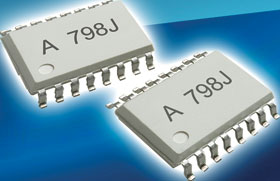

With its differential output, the new Hunter EBVchip can reliably transmit galvanically separated measurement signals from sensors to digital processing electronics, even in environments with heavy electromagnetic interference.
A major task of many motor control units, data recording systems and industrial process control units, as well as many different current measurement and monitoring applications, involves transmitting measurement data delivered by sensors to the control electronics.
In drives, for example, the currents and link voltage must be measured. The sensors required for this are directly integrated into the power circuit in the HV system but the control electronics work only with LV technology at voltages of 5 or 3,3 V.
In order to prevent damage to people or property, the sensor circuit must be galvanically separated from the control circuit for safety reasons. There must be no electrical connection between the two circuits.
The methods and test standards for galvanic separation are very well known to the industry. Depending on the solution, three different coupling procedures are used: capacitive, inductive or optical coupling.
A method that is particularly appreciated in the industry, thanks to its robustness and reliability, involves galvanically separated sigma-delta modulation, where the signals are transmitted optically. At its output, converters of this type supply a high-frequency data stream at a frequency of up to 25 MHz, as well as a clock signal.
The sigma-delta method works in a similar way to pulse width modulation. If a value of zero is present at the input, only zeroes are transmitted. If the maximum value is present at the input, the line permanently transmits the value one; if the value present at the input is 50%, the value one and the value zero are each transmitted 50% of the time.
The control electronics evaluate this signal delivered by the sigma-delta modulator. To evaluate these signals, EBV customers frequently use an FPGA in which a sinc3 filter has been implemented. In this regard, the FalconEye reference design created by EBV Elektronik has proven to be of particular value.
However, problems occur in some applications when transmitting the 20 MHz signal to/from the sigma-delta ADC (analog-to-digital converter) because this signal does not always pass through the line or the circuit board without problems or in an EMC-compliant manner.
Since this problem kept arising, EBV Elektronik started looking for a solution and found it by using a differential data stream for this data transmission. An Avago converter, type ACPL-796J, which was already available on the market, was used as the basis. This product offers safe, TÜV-certified separation between both sides. With regard to creepage distance, transient strength, protective circuits, etc., the new EBVchip is in line with the ACPL-796J, which has already proven itself on the market.
The new converter, designated ACPL-798J, delivers a differential LVDS (low-voltage differential signalling) signal at the output. In this modified variant, the signals reach their destination reliably in environments where there is heavy electromagnetic interference (EMI).
As the ACPL-798J generates differential output signals and the electromagnetic interference affects both output lines simultaneously, and with practically the same intensity, the useful signal at the destination can be recovered by subtracting the two signals, while the interfering signals caused in both lines cancel each other out during this subtraction.
While the standard output, which issues a signal relative to earth, works at a 5 or 3,3 V level, differential signal transmission via LVDS can operate at much lower levels. In accordance with its standard, LVDS uses a differential 200 mV level, whose direct current share is ultimately cancelled out.
During LVDS signal transmission, this results in a much lower power loss than in conventional single-ended signals. Most FPGAs can work with LVDS signals without any difficulty. As a result, virtually no modifications are necessary on the evaluation side.
This innovative LVDS isolated delta-sigma modulator is available from EBV Elektronik under the EBVchip programme with the project name Hunter or ACPL-798J.
Hunter conforms to insulation class IIIa in accordance with DIN VDE 0110 and works with external clock sources in the 15 to 25 MHz range. The clock pulse is reliably transmitted across the galvanic separation, allowing the module to perform the data acquisition synchronously with any digital controller.
The module even transmits the encoded modulator data across the galvanically separated route. The data is recovered, decoded and converted into a serial data stream on the other side.
With a typical signal/noise ratio of 78 dB with an appropriate digital filter, differential non-linearity of 0,9 LSB with a resolution of 16 bits resolution no missing codes (12 bits ENOB) and a typical gain error of 2%, the Hunter, which has been designed for ambient temperatures of -40°C to +105°C, is suitable for a large number of industrial applications.
For more information contact EBV Electrolink, +27 (0)21 402 1940, [email protected], www.ebv.com
| Tel: | +27 11 236 1900 |
| Email: | [email protected] |
| www: | www.ebv.com |
| Articles: | More information and articles about EBV Electrolink |

© Technews Publishing (Pty) Ltd | All Rights Reserved